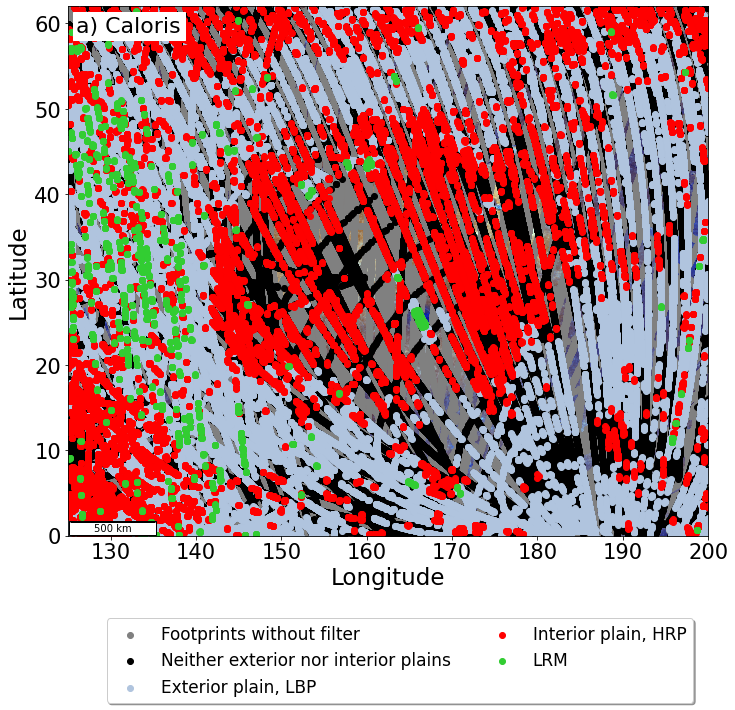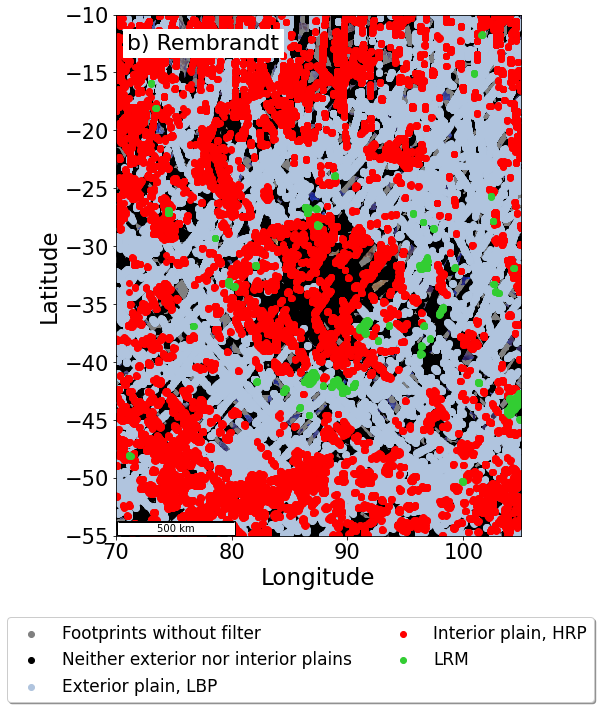Impact basins and their associated smooth plains on Mercury using MESSENGER/MASCS observations
- 1Observatoire de Paris , LESIA, France (emma.caminiti@obspm.fr)
- 2Aurora Technology B.V., European Space Astronomy Centre/ESA, Madrid, Spain
Introduction:
The study of geological processes such as cratering and volcanism provides information on the evolution of Mercury's crust since its formation. The well-preserved, approximately 4 Ga, Caloris basin is one of the most important geological features on Mercury [1] [2] [3]. The basin is associated with two smooth plains, Caloris Planitia inside the basin and the Circum-Caloris smooth plain respectively called interior and exterior plains [4]. These two plains are spectrally different [5] [6]. The interior plain has a high reflectance that increase with wavelengths associated to the High-reflectance Red Plains (HRP) spectral unit. The exterior plain is bluer and have a lower reflectance being part of the Low reflectance Blue Plains (LBP). The interior and exterior plains appear to be both mostly volcanic in origin and emplaced after the formation of the basin although the timing of their establishment and the understanding of their spectral differences remain debated. The formation of large impact basins can bring to the surface deep material sampling the earliest carbon rich crust now buried under the secondary magmatic crust [7]. This deep excavated material is at the origin of the Low Reflectance Material (LRM) spectral unit [8]. A detailed spectral study of Caloris is proposed with the aim of improving our understanding of the setting up of volcanic smooth plains associated with basins. We also propose a comparison with other basins in order to understand whether the location of basins on Mercury has any influence on the setting up of volcanic plains.
Method:
We created spectral maps using on a one hand multispectral images obtained by the Mercury Dual Imaging System (MDIS/MESSENGER) and on another hand spectral observations acquired by the Mercury Atmospheric and Surface composition Spectrometer (MASCS/MESSENGER). MASCS data are contained in the MeSS (Mercury Surface Spectroscopy) database as well as several spectral parameters. We filtered the MASCS footprints, keeping only those with an instrumental temperature below 40 degrees Celsius, an angle of incidence below 75 degrees and an area of less than 65 km2. Then, the samplings of the interior HRP and exterior LBP have been done within the Caloris basin. The LRM was sampled around the Rachmaninoff, Tolstoj, Basho and Atget craters. A statistical study of the sampled areas allowed us to obtain a spectral characterization for each of the units. This spectral characterization was then used to map the different spectral units interacting in the setting of the basin and the current state of the crust.
Results:
Our spectral characterization allows to distinguish the interior from the exterior plains of the Caloris basin (Figure 1.a). We highlight the presence of LRM concentrated in the western part of the exterior plain. It is also possible to identify LRM excavated from craters located on the interior plain. Focusing on the small craters located on the interior plain, we can see that there are LBP deposits around the LRM deposits themselves concentrated in the craters. This arrangement of spectral units provides information on the stratigraphy under the basin and thus the timing of the Caloris basin volcanic plains [2][9]. The study of the second largest basin Rembrandt (Figure 1.b) located in the southern hemisphere shows an arrangement of spectral units close to that of Caloris with an interior HRP filling the basin and exterior LBP both associated with partial LRM deposits.


Figure 1: Spectral maps: each point represents a footprint of MASCS and each color is associated to a spectral unit. a) Caloris basin b) Rembrandt basin.
Conclusion:
Spectral data from MESSENGER/MASCS allow us to map the spectral units on the surface of Mercury. The asymmetric LRM deposits in the western part of the basin suggests that it is possible that the process of laying down the exterior plain is not homogeneous all around the basin and seems to be related to the geochemistry of the crust. Results also suggest that the circum-Caloris volcanic smooth plain could have been set up before the interior plain. The comparison with the Rembrandt basin shows that the location of the basins may not be a major parameter in the setting up of the volcanic smooth plains on Mercury's surface. Even if the local properties of the crust are not negligible, the setting up of smooth plains could be related to impact processes and so be common to all impact basins. Extrapolating our results to multiple basins it is possible to bring some precisions concerning the nature of the smooth plains whose relationship between volcanism and impact melt remains ambiguous.
Acknowledgements:
The authors acknowledge the Centre National des Etudes Spatiales (CNES) for continuous and support.The authors would also like to thank the Domaine d’Intérêt Majeur en Astrophysique et Conditions d’Apparition de la Vie+ île de France for their support. The authors acknowledge the use of MESSENGER data.
References:
- Murchie, S. L. et al. Geology of the Caloris Basin, Mercury: A View from MESSENGER. Science. (2008).
- Fassett, C. I. et al. Caloris impact basin: Exterior geomorphology, stratigraphy, morphometry, radial sculpture, and smooth plains deposits. Earth and planetary Science Letters. (2009).
- Marchi, S.Global resurfacing of Mercury 4.0–4.1 billion years ago by heavy bombardment and volcanism. Nature. (2013)
- Rothery, D. A. et al.Caloris basin: Continuity between the interior and exterior plains: Mercury’s Caloris Plains. Journal of Geophysical Research. (2017)
- Robinson, M. S. et al. Reflectance and Color Variations on Mercury: Regolith Processes and Compositional Heterogeneity. Science (2008).
- Denevi, B. W . et al. The Evolution of Mercury’s Crust: A Global Perspective from MESSENGER. Science. (2009)
- Peplowski, P.N et al. Remote sensing evidence for an ancient carbon-bearing crust on Mercury. Nature Geoscience. (2016)
- Klima, R. L. et al. Global Distribution and Spectral Properties of Low‐Reflectance Material on Mercury. Geophysical Researcher Letters. (2018)
- Ernst, C. M. Stratigraphy of the Caloris basin, Mercury: Implications for volcanic history and basin impact melt. Icarus. (2015)
How to cite: Caminiti, E., Doressoundiram, A., and Besse, S.: Impact basins and their associated smooth plains on Mercury using MESSENGER/MASCS observations, Europlanet Science Congress 2022, Granada, Spain, 18–23 Sep 2022, EPSC2022-319, https://doi.org/10.5194/epsc2022-319, 2022.

